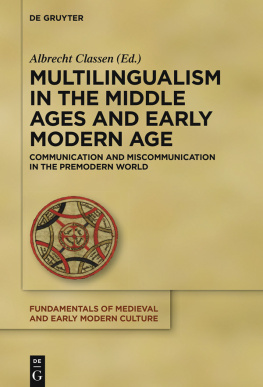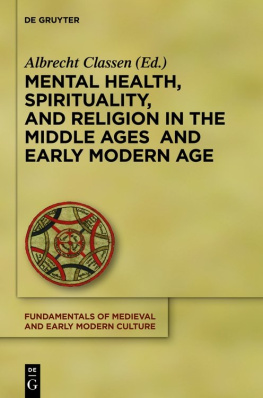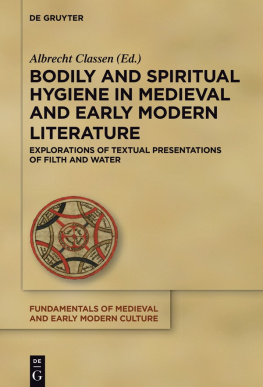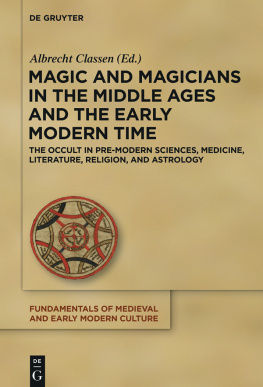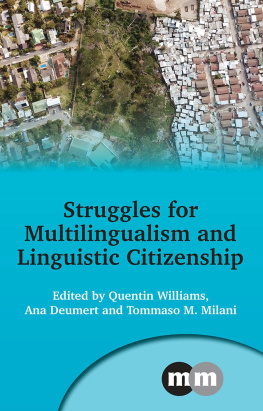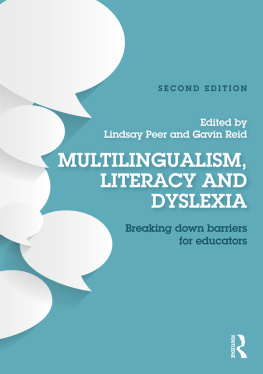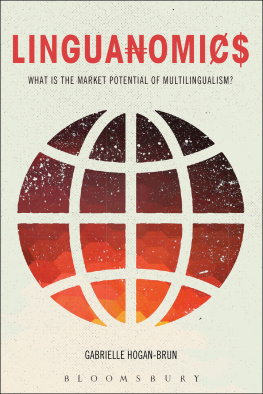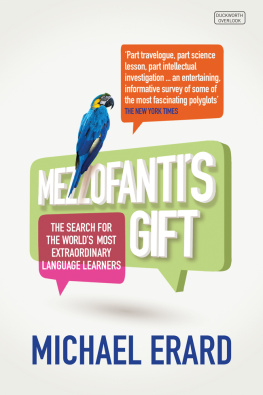Guide

Multilingualism in the Middle Ages and Early Modern Age
Fundamentals of Medieval and Early Modern Culture

Edited by
Albrecht Classen and Marilyn Sandidge
Volume 17

ISBN 978-3-11-047096-3
e-ISBN (PDF) 978-3-11-047144-1
e-ISBN (EPUB) 978-3-11-047090-1
ISSN 1864-3396
Library of Congress Cataloging-in-Publication Data
A CIP catalog record for this book has been applied for at the Library of Congress.
Bibliographic information published by the Deutsche Nationalbibliothek
The Deutsche Nationalbibliothek lists this publication in the Deutsche Nationalbibliografie;
detailed bibliographic data are available on the Internet at http://dnb.dnb.de.
2016 Walter de Gruyter GmbH, Berlin/Boston
www.degruyter.com
Albrecht Classen (The University of Arizona)
Multilingualism in the Middle Ages
Theoretical and Historical Reflections. An Introduction
Throughout human history two issues have always stood out as fundamental, supporting and promoting society at large: languages and communication. There are many criteria to define human existence and culture, but there is universal agreement that language provides us with more specific characteristics than any other phenomenon in order to interact with our social environment and context. It would probably be more accurate to talk in plural here, since no language simply stands alone by itself, being completely free from external influences. Even rigid language control cannot prevent a strong impact by surrounding or neighboring languages, although some exceptions, like the language of the Basques, Euskara, seem to confirm this rule, since it was never influenced by the Latin spoken by the colonizing Romans who were in full control of the Iberian Peninsula since ca. 19 B.C.E.
All languages serve individuals to communicate with others and hence to create a human community. We would probably not be able to survive as human beings without our ability to express our thoughts and feelings and to exchange them with our fellow-beings. In other words, we must convey our needs, fears, desires, our happiness and joy in one way or the other. Not surprisingly, one of the worst forms of punishment, apart from torture and execution, is total isolation, the denial of the human contact, especially total silence, which has been tragically practiced both in the past and also in the present.
However, before we proceed further, let us make clear that human ideas, feelings, or concerns can be formulated in many different ways, hence not only by means of spoken or written words and sentences. Language or rather communication can consist of gestures, mimicry, images, sounds, knots, or music, as long as any of those media allows the individual to communicate in an efficient manner. This requires, of course, a mutual agreement that any of those signs, gestures, images, or words really mean what they are supposed to convey, and that the receivers understand those signals accordingly.
Turning to Genesis in the Old Testament, we find the famous example of The Tower of Babel , in 11:19. The origin of all languages is assumed to have been a universal medium of communication, and this in conformity with ancient, Platonic, philosophy according to which all phenomena in this world are the result of an evolutionary process, moving from the one harmonious origin to an endless plethora of future entities, that is, from the seed to the flower, for instance, or to the Good being the origin and also goal of all things and beings (Boethius, d. 525).
However, as the biblical author informs us: They said to each other, Come, lets make bricks and bake them thoroughly. They used brick instead of stone, and tar for mortar. Then they said, Come, let us build ourselves a city, with a tower that reaches to the heavens, so that we may make a name for ourselves; otherwise we will be scattered over the face of the whole earth. Once God realized the danger of global hubris involved in erecting the tower for mankind, which was possible because all people spoke just one language, He confused their languages and thus broke them all apart: So the Lord scattered them from there over all the earth, and they stopped building the city. That is why it was called Babelbecause there the Lord confused the language of the whole world. From there the Lord scattered them over the face of the whole earth (Gen. 11: 89).
Since that time, as this mythological, or divinely inspired, account indicates, people spoke different languages, and, as a result of that, problems and conflicts emerged that continue to dominate even the modern world. In other words, as the biblical author clearly recognized, language and languages prove to be the critical benchmark of all human existence. The person or institution that controls languages, that is, that can speak many languages, or employs them in at least a mechanical fashion, also controls the world. Today, of course, we have available an ever growing number of computer-based gadgets and software programs that allow us to have our words and sentences translated mechanically into almost any language, but this does not mean at all that most people have the communicative means available to build bridges to any other social communityon the contrary. In one sense, the European Middle Ages were blessed in having Latin available as the lingua franca at least for all intellectuals. French enjoyed a fairly similar status from the seventeenth through the nineteenth century, and English, today specifically American English, does the same. But in another sense, as many literary works from the pre-modern era already indicate to us, this specific situation did not make communication any easier.
All this pertains to the issue of communication, but not to bi- and multilingualism, which continues to matter greatly, and seems to gain in importance all the time in our present world considering the massive number of immigrants from the south to the north and the west, which creates a challenging mix of Indo-European with Arabic and many other languages. These millions of people mostly arrive as monolinguals, or as speakers of several languages not related to Indo-European, but they are quickly forced to acquire the new language in order to communicate with the new social environment, whether they achieve true mastery in the new language/s or not.
The huge number of distinct languages (at least ca. 6000) and of dialects (at least ca. 24,000) spoken all over the world is mind-boggling, all of them confirming the virtually endless capacities of the human brain, ever creating new languages and evolving old ones. going process of adaptation, expansion, simplification or diversification, as any historical linguist can confirm. Languages and dialects can be very traditional and maintain their standard features over a long period of time, or they can be subject to a multiplicity of influences from outside (and inside) and so experience an infinite process of transformation.
But let us stay a little longer with the Bible, now turning to the New Testament, where we find another famous example of what languages mean and how they affect all of human culture. Since the Tower of Babel incidence, it is completely understood everywhere that people speak different languages and that this regularly causes problems and conflicts. If we do not understand each other, which brings about misunderstandings even among speakers of the same language, aggression, frustration, fear, and even violence can break out. Consequently, the world of translators has always been regarded with great respect, both in antiquity and in the Middle Ages. Translators prove to be most effective, though certainly not perfect intermediators between two or more languages and hence cultures and people. As soon as the language barrier falls away, amazing rapprochements can and do take place, although this is certainly not a guarantee. This phenomenon is already powerfully illustrated in the lives of Christs apostles, as we can read in Acts 2:113. The text expresses clearly enough what happened and what the future of mankind consists of in terms of all of our communicative means:

